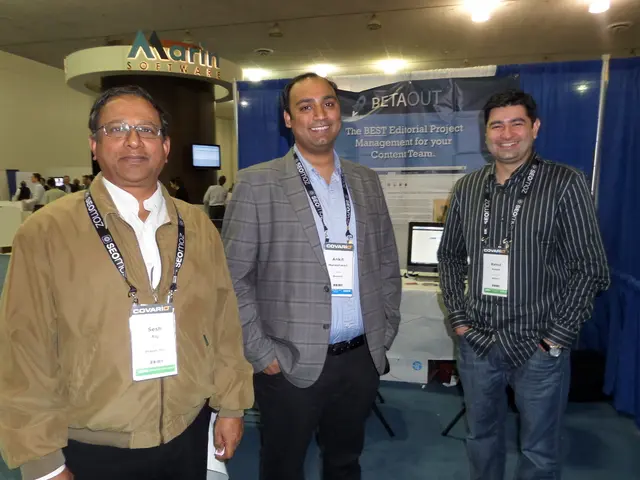Controversy Surrounds Ethereum's Story as Debate Rages Over Its Role as a Store of Value and Revenue Source
The Ethereum Chaos: A Battle of Narratives Eroding its Dominance
The Ethereum network, once the guiding light of Web3, is now teetering on the edge, as its core value proposition gets tangled in internal debates.
Crypto Titans Clash Over Ethereum's Dilemma
Zach Rynes, a Community Liaison at Chainlink, claims Ethereum lacks a cohesive economic narrative, a shift that has left the network open to constant narrative shifts, undermining investor conviction. As he puts it, "We're still tugged between two extremes. One vouching for revenue as the primary tale (think ultrasound economy or yield talk) and the other, Store of Value (SoV)," Rynes stated.
Each camp insists they're right, while the other is wrong. This, according to Rynes, is a dangerous game in the face of intensifying competition.
The Ultrasound Money Fork in the Road
The 'ultrasound money' narrative held strong during Ethereum's peak fee era in 2021. However, its cracks have appeared with the rise of Layer-2 networks like Arbitrum and Optimism, Which have been absorbing a growing share of gas fees and MEV (Maximal Extractable Value).
This shift has left Ethereum with reduced Layer-1 revenue and a declining economic foothold. "Ethereum gave away the most valuable piece of the stack to L2s while optimizing for the least valuable part. Now it needs ridiculous on-chain volume just to make its economics work," Rynes noted.
On the opposite end of the debate, Ethereum educator and angel investor Sassal underscored the necessity for ETH to fully embrace its SoV role, stating, "If ETH is valued based solely on revenues, it'll never be worth much."
Ethereum: Gold or Tech-Token?
Sassal argues that Ethereum's sustainable SoV status depends on a widely held narrative, akin to Bitcoin's 'digital gold' reputation. However, Ethereum's scattered positioning is starkly contrasted by Bitcoin's consistent branding. Critics like PlanB, the creator of the Stock-to-Flow model, have called out Ethereum's centralization and pre-mined origins, branding it a 'technocratic governance coin' rather than a decentralized hard asset.
Heaven forbid, internal developer conflicts amplify these concerns. A recent dispute over Ethereum's roadmap and L2 design philosophies highlights ongoing governance strain, further clouding Ethereum's story.
Meanwhile, rival chains like Solana (SOL) and BNB Chain are marching forward with unified narratives. Speed, cost efficiency, and developer experiences cast long shadows over Ethereum's future.
So long as Ethereum can't define its economic identity, it risks slipping into obscurity amidst simpler, faster, or more ideologically united chains.
It may need to craft a narrative to preserve its market dominance and Web3 leadership. This could potentially involve integrating its programmability, security, and decentralization without leaning too heavily on misleading comparisons or revenue illusions.
As Rynes said, "ETH needs to be its own asset with its own tale—and nobody has quite figured that out yet." Will Ethereum unravel its identity crisis before it's left behind by the market, or will it become a case study in fragmented innovation?
TonTrader | dYdX | Arkham | BingX | HTX *TonTrader | dYdX | Arkham | BingX | HTX*Disclaimer
Adhering to the Trust Project guidelines, BeInCrypto aims to deliver unbiased, transparent reporting. This news article aims to provide accurate, timely information. Users are advised to verify facts independently and consult a professional before making decisions based on this content. BeInCrypto has updated its Terms and Conditions, Privacy Policy, and Disclaimers.
- Zach Rynes asserts that Ethereum lacks a cohesive economic narrative, leading to constant shifts and undermining investor confidence.
- Rynes highlights the tension between narratives of revenue and Store of Value within the Ethereum community.
- The 'ultrasound money' narrative, popular during Ethereum's high gas fee period in 2021, has shown cracks with the rise of Layer-2 networks (Arbitrum and Optimism), absorbing gas fees and MEV.
- Sassal argues that for Ethereum to sustain its SoV status, a widely held narrative akin to Bitcoin's 'digital gold' reputation is essential.
- Critics like PlanB have called out Ethereum's centralization and pre-mined origins, branding it a 'technocratic governance coin' rather than a decentralized hard asset.
- Internal developer conflicts amplify these concerns, as seen in the recent dispute over Ethereum's roadmap and L2 design philosophies.
- Rival chains like Solana (SOL) and BNB Chain are advancing with unified narratives, focusing on speed, cost efficiency, and developer experiences.
- Ethereum's future could be at risk if it can't define its economic identity, potentially involving promoting its programmability, security, and decentralization without resorting to misleading comparisons or revenue illusions.
- Rynes suggests Ethereum needs to be its own unique asset with its own narrative—one that hasn't been fully figured out yet.
- The question remains whether Ethereum can resolve its identity crisis before it's left behind by the market or become a case study in fragmented innovation, given the competition from other blockchain networks.










